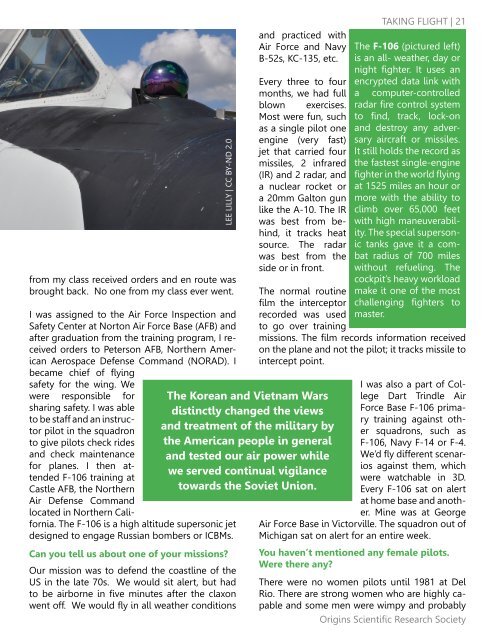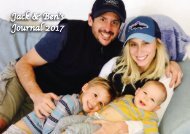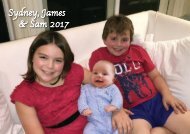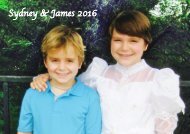Issue 10: Tech from the Military
Exploring how the military shaped the technology many of us depend on or simply desire to use on a daily basis.
Exploring how the military shaped the technology many of us depend on or simply desire to use on a daily basis.
Create successful ePaper yourself
Turn your PDF publications into a flip-book with our unique Google optimized e-Paper software.
<strong>from</strong> my class received orders and en route was<br />
brought back. No one <strong>from</strong> my class ever went.<br />
I was assigned to <strong>the</strong> Air Force Inspection and<br />
Safety Center at Norton Air Force Base (AFB) and<br />
after graduation <strong>from</strong> <strong>the</strong> training program, I received<br />
orders to Peterson AFB, Nor<strong>the</strong>rn American<br />
Aerospace Defense Command (NORAD). I<br />
became chief of flying<br />
safety for <strong>the</strong> wing. We<br />
were responsible for<br />
sharing safety. I was able<br />
to be staff and an instructor<br />
pilot in <strong>the</strong> squadron<br />
to give pilots check rides<br />
and check maintenance<br />
for planes. I <strong>the</strong>n attended<br />
F-<strong>10</strong>6 training at<br />
Castle AFB, <strong>the</strong> Nor<strong>the</strong>rn<br />
Air Defense Command<br />
located in Nor<strong>the</strong>rn California.<br />
The F-<strong>10</strong>6 is a high altitude supersonic jet<br />
designed to engage Russian bombers or ICBMs.<br />
Can you tell us about one of your missions?<br />
LEE LILLY | CC BY-ND 2.0<br />
Our mission was to defend <strong>the</strong> coastline of <strong>the</strong><br />
US in <strong>the</strong> late 70s. We would sit alert, but had<br />
to be airborne in five minutes after <strong>the</strong> claxon<br />
went off. We would fly in all wea<strong>the</strong>r conditions<br />
and practiced with<br />
Air Force and Navy<br />
B-52s, KC-135, etc.<br />
Every three to four<br />
months, we had full<br />
blown exercises.<br />
Most were fun, such<br />
as a single pilot one<br />
engine (very fast)<br />
jet that carried four<br />
missiles, 2 infrared<br />
(IR) and 2 radar, and<br />
a nuclear rocket or<br />
a 20mm Galton gun<br />
like <strong>the</strong> A-<strong>10</strong>. The IR<br />
was best <strong>from</strong> behind,<br />
it tracks heat<br />
source. The radar<br />
was best <strong>from</strong> <strong>the</strong><br />
side or in front.<br />
The normal routine<br />
film <strong>the</strong> interceptor<br />
recorded was used<br />
to go over training<br />
The Korean and Vietnam Wars<br />
distinctly changed <strong>the</strong> views<br />
and treatment of <strong>the</strong> military by<br />
<strong>the</strong> American people in general<br />
and tested our air power while<br />
we served continual vigilance<br />
towards <strong>the</strong> Soviet Union.<br />
TAKING FLIGHT | 21<br />
The F-<strong>10</strong>6 (pictured left)<br />
is an all- wea<strong>the</strong>r, day or<br />
night fighter. It uses an<br />
encrypted data link with<br />
a computer-controlled<br />
radar fire control system<br />
to find, track, lock-on<br />
and destroy any adversary<br />
aircraft or missiles.<br />
It still holds <strong>the</strong> record as<br />
<strong>the</strong> fastest single-engine<br />
fighter in <strong>the</strong> world flying<br />
at 1525 miles an hour or<br />
more with <strong>the</strong> ability to<br />
climb over 65,000 feet<br />
with high maneuverability.<br />
The special supersonic<br />
tanks gave it a combat<br />
radius of 700 miles<br />
without refueling. The<br />
cockpit’s heavy workload<br />
make it one of <strong>the</strong> most<br />
challenging fighters to<br />
master.<br />
missions. The film records information received<br />
on <strong>the</strong> plane and not <strong>the</strong> pilot; it tracks missile to<br />
intercept point.<br />
I was also a part of College<br />
Dart Trindle Air<br />
Force Base F-<strong>10</strong>6 primary<br />
training against o<strong>the</strong>r<br />
squadrons, such as<br />
F-<strong>10</strong>6, Navy F-14 or F-4.<br />
We’d fly different scenarios<br />
against <strong>the</strong>m, which<br />
were watchable in 3D.<br />
Every F-<strong>10</strong>6 sat on alert<br />
at home base and ano<strong>the</strong>r.<br />
Mine was at George<br />
Air Force Base in Victorville. The squadron out of<br />
Michigan sat on alert for an entire week.<br />
You haven’t mentioned any female pilots.<br />
Were <strong>the</strong>re any?<br />
There were no women pilots until 1981 at Del<br />
Rio. There are strong women who are highly capable<br />
and some men were wimpy and probably<br />
Origins Scientific Research Society


















